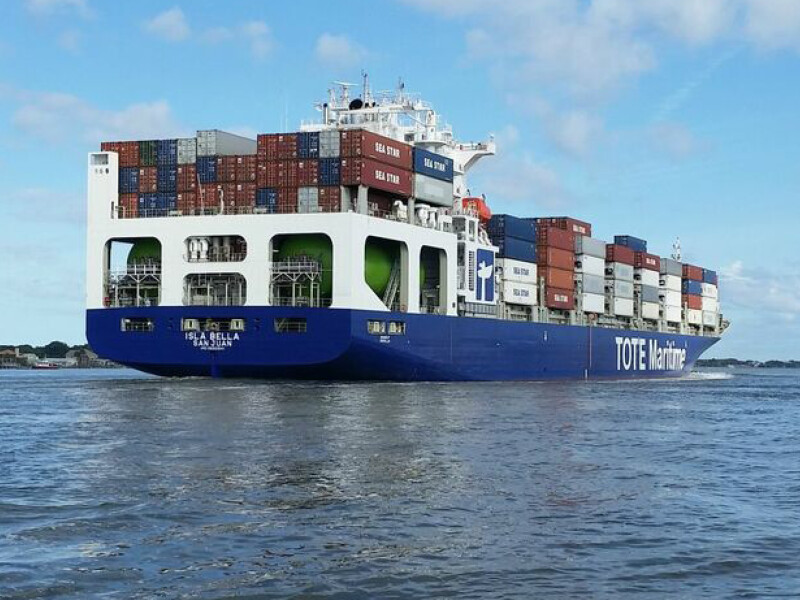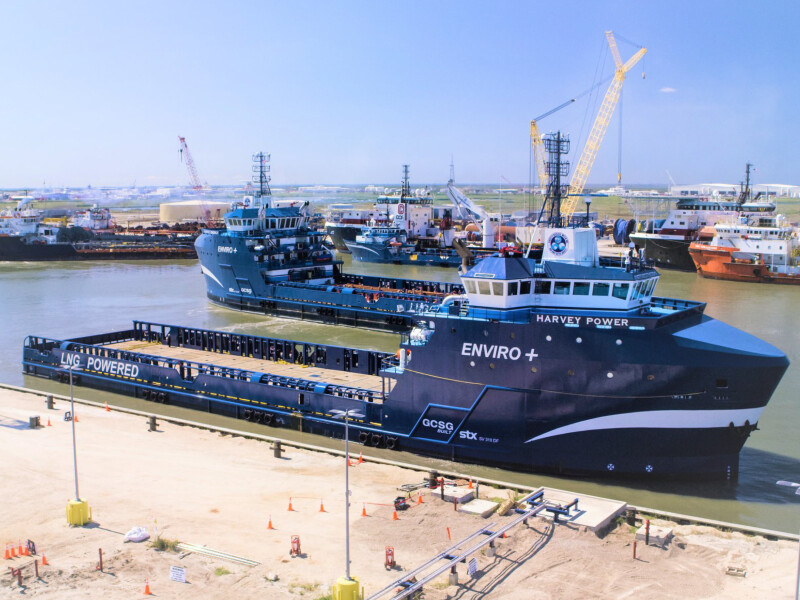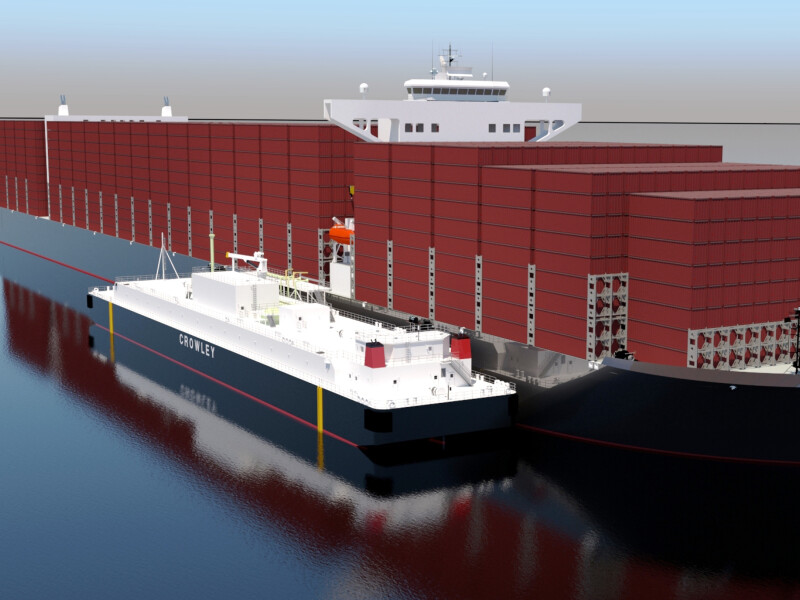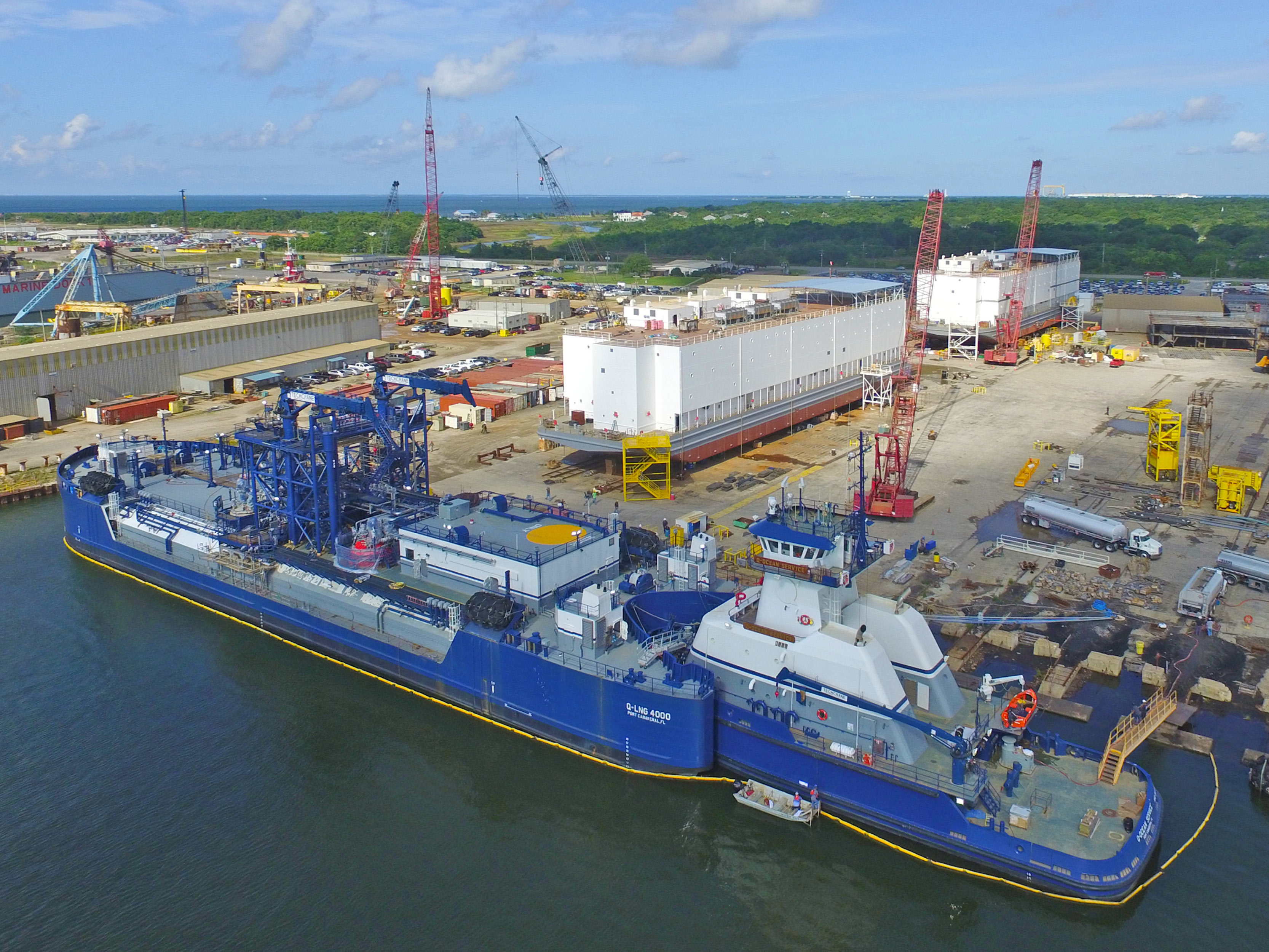It’s the 2020s and maritime companies are starting to scramble, like it or not, to cut greenhouse gas emissions. For those operating under the International Maritime Organization rules, the established guidelines for decarbonization target a 40% reduction by 2030 and 70% by 2050, compared with 2008 emissions. For others, it’s demand from customers that motivates decarbonization. And for a few, it’s just the right thing to do.
One way to reduce carbon emissions is to simply burn less fuel by increasing efficiency and reducing speed, but those strategies are limited and sometimes impractical. Another method is to operate on alternative fuels, such as LNG, hydrogen, methanol, ammonia, or electricity. Of these, LNG has been adopted at the largest scale, so far.
Natural gas, of course, is itself a fossil fuel, but it does burn more cleanly than fuel oils such as diesel. Burning LNG creates emissions with almost no particulate matter or sulfur oxides, and nitrous oxides are greatly reduced. As such, liquified natural gas as a marine fuel is compliant with both SOx and NOx emission limits in coastal Emission Control Areas (ECAs). It’s also seen as a bridge to low-carbon or zero-carbon marine operations.
Burning LNG as a marine fuel does emit less CO2 than traditional fuel oils — about 21%-28% less — depending on how it’s measured and whether it’s calibrated from well-to-wake, which includes all production and distribution emissions, or tank-to-wake.
LNG is also an attractive alternative fuel because it’s usually less expensive than diesel. And because it burns more cleanly, engines may last longer and require less maintenance.
Internationally, LNG marine fuel is being adopted quickly by the shipping and cruise industries, which appreciate its soot-free exhaust. According to SEA-LNG, an international multi-sector industry coalition created to accelerate the adoption of LNG as a marine fuel, “2021 marked exponential growth in LNG-fueled deep-sea vessel orders, with more than a dozen operators announcing multivessel orders.” These include containerships, tankers, cruise ships, bulk carriers, car carriers, and ferries. “The rapidly growing order book for LNG-fueled vessels demonstrates that increasing numbers of ship owners and operators understand that the LNG pathway is clear and well defined,” according to SEA-LNG. The pathway leads to decarbonization.

U.S. LNG USE
Here in North America, both TOTE Maritime and Crowley Maritime have switched to LNG as fuel for their Jones Act-compliant, container/ro-ro operations. TOTE has now built two LNG-powered, 764' Marlin-class containerships for its Florida to Puerto Rico operations, and is currently converting its 839’ Orca-class ships to LNG for its Puget Sound to Alaska operations. And in the past few years, Crowley has added two new 720', LNG-powered, Commitment-class con-ro vessels that operate between Florida and Puerto Rico. All of these vessels operate in ECAs and meet those standards by using LNG marine fuel.
TOTE’s and Crowley’s ships all operate with dual-fuel engines, which means they can burn fuel oil or LNG. In fact, they burn both. For LNG to ignite, it requires either a pilot fuel explosion in the engine’s cylinder or a spark-ignited explosion. In practice, operators inject the smallest amount of diesel into the engine as possible.
Cole Cosgrove, Crowley’s vice president of marine operations, said the percentage of diesel as pilot fuel is less than 3% in their vessels. But, by choosing dual-fuel engines, operators have the option of burning all diesel if LNG isn’t available or if the price isn’t right.
LNG availability is one of the key issues in deciding to power vessels with gas.
“The whole thing about introducing a new fuel is that it’s a chicken and an egg,” said John Waterhouse, a principal, and founder at Elliott Bay Design Group in Seattle. “You’re not going to build a vessel to burn LNG unless you’re sure you can buy LNG fuel wherever your vessel needs to go.”
Natural gas is plentiful in the U.S. but loading that gas into a vessel demands liquefaction to make it LNG. This process requires supercooling the gas to -260 (-160 C) and keeping it stored at that temperature. Once supercooled as a liquid, LNG can be transferred from shoreside facilities to vessels or vice versa. But it must be kept cold the entire time or it starts to boil off, which increases the pressure inside whatever tank it’s in. If that tank is on a ship, the boiled-off gas can be fed to engines as fuel. Preventing or reducing boil-off requires heavily insulated tanks, which is another stumbling block for LNG as a marine fuel, especially for smaller vessels.
“The problem with liquefied natural gas as a fuel is twofold,” said Waterhouse. “One, it takes more space in the boat for an equivalent amount of energy, and two, it involves expensive cryogenic tanks to store it in. So, it not only takes more volume but it requires a very expensive special technology.”
Tucker Gillam, Crowley’s vice president of marine assets, said LNG tankage on board is definitely a challenge. “With traditional liquid fuels you can integrate the fuel tanks into the voids and the shape of the hull fairly easily,” he said, “but because of the insulation and cryogenic requirements that LNG has, typically you need to have some sort of separate tank that takes up a lot of space.”
Depending on the vessel, that space could be used for cargo. The LNG tanks must also be carefully located, not under any crew accommodations, to satisfy Coast Guard requirements.

HARVEY GULF AND LNG
One of the most visible and successful adaptors of LNG as a marine fuel in the U.S. is Harvey Gulf International Marine, New Orleans. Led by its CEO Shane Guidry, characterized as “a real visionary” by an engine vendor in the Gulf, HGIM built and operates the first and only LNG-powered workboats in the U.S., other than the con-ro ships. HGIM’s five 310’ offshore supply vessels with dual-fuel engines are also being adapted to operate at least partially on batteries, making them tri-fuel vessels and even more environmentally friendly.
To support its own LNG-powered vessels, HGIM built an LNG storage and bunkering facility at Port Fourchon, La. With that facility, HGIM not only bunkers LNG for its own fleet, but it can supply others through its subsidiary, Q-LNG Transport.
The company now owns and operates the world’s first ATB LNG bunkering barge, the Q-LNG 4000, which can carry 4,000 cubic meters of LNG. The 324' barge is pushed by a 128' tug, the Q-Ocean Service, both built at VT Halter Marine, Pascagoula, Miss. The LNG ATB provides ship-to-ship transfers and ship-to-shore transfers to small-scale marine distribution infrastructure. The ATB was built in partnership with Shell Trading. Q-LNG has also been planning the construction of an 8,000-cubic-meter ATB to meet growing demand.
The demand for bunkered LNG for international shipping and entertainment cruising has also inspired Polaris New Energy, a subsidiary of Northstar Terminals, to have a 5,500-cubic-meter LNG bunker barge built at Fincantieri Bay Shipbuilding, Sturgeon Bay, Wis. The 340'x66'x32'10" ATB Clean Canaveral was delivered in December. It will be pushed by the 4,000-hp tug Polaris being built for McAllister Towing LNG Services at Master Boat Builders, Bayou La Batre, Ala. McAllister will operate the ATB Polaris/Clean Canaveral for Polaris New Energy.
Around the time of delivery, the buyer and the builder announced a contract to build a second 5,500-m3 LNG ATB. The ATB will be a sister vessel to the Clean Canaveral.

In January, Bay Shipbuilding announced it had started construction on the largest LNG bunkering barge ever built in the U.S. The new LNG bunker barge for Crowley Maritime is to be chartered by Shell NA LNG. The 416' barge will have a 12,000-m3 capacity, making it the largest Jones Act-compliant vessel of its kind. It will be deployed on the East Coast starting in 2024. It will be the second Jones Act-compliant bunker barge Shell has under a time charter in the U.S. The vessel is designed by Crowley Engineering Services.
In British Columbia, Canada, BC Ferries was expected to receive it's fourth Salish-class, dual-fuel, LNG-powered ferry in February. The 350’ car ferries were built at Remontowa Shipbuilding SA in Gdańsk, Poland. BC Ferries has also converted its largest vessels, the two 550' Spirit-class ferries, to LNG operations in 2018 and 2019 at the same shipyard. The LNG-fueled vessels are part of BC Ferries’ Clean Futures Plan that outlines a path “to replace diesel fuels with cleaner, lower carbon-intensity options.” Those options also include six new Island-class diesel-electric hybrid ferries.
Also in British Columbia, Seaspan Ferries, Vancouver, has been transitioning to LNG fuel with the addition of two LNG/hybrid-electric, ro-ro freight ferries that service Vancouver Island. The 488’ vessels were built by Damen Shipyards in Romania. Seaspan Ferries president Frank Butzelaar said the LNG hybrid vessels operated with “emissions reductions of over 50 percent compared to traditional vessels,” during their first two years of service.
“We see LNG as the near-term pathway to lowering our carbon footprint in marine shipping,” said Crowley’s Gillam. “Renewable LNG has the ability to take that even further, so that’s something that we’re exploring and we’re keeping an eye on. But LNG is what’s available today, and we can’t just wait around for the magic bullet. Who knows what’s going to prevail in 20 years – is that going to be LNG, methanol, ammonia, hydrogen? Tough to say.”




